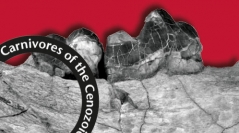

 Geodiversitas
41 (21) - Pages 731-745
Geodiversitas
41 (21) - Pages 731-745We describe two large amphicyonid (Amphicyonidae, Carnivora) mandibles from Moghra, Early Miocene, Egypt. One of these represents a new species of Cynelos Jourdan, 1862, which is in the same size range as C. macrodon (Savage, 1965) and C. ginsburgi n. comb., but exhibits a relatively longer m1 paraconid blade. The other is allocated to Amphicyon giganteus (Schinz, 1825). Based on this new material the differences between Cynelos, Amphicyon Lartet in Michelin, 1836, and Afrocyon Arambourg, 1961 are clarified. We also reassign three (P4, M1, M2) of four isolated and unassociated amphicyonid teeth from Moghra, previously attributed to “Cynelos sp. nov.” to Amphicyon giganteus. These teeth represent the first record of the upper dentition of A. giganteus from Africa. Enhanced diagnoses of Cynelos and Amphicyon also permit the reallocation of some other previously described specimens to these taxa. These include: assignment of “Amphicyon sp.” and an isolated m2 previously identified as “Afrocyon burolleti Arambourg, 1961” from Gebel Zelten, Libya, to the new species of Cynelos; allocation of “Ysengrinia” ginsburgi from Arrisdrift, South Africa, to Cynelos ginsburgi n. comb.; and attribution of a giant undescribed additional species from Buluk, Kenya to Cynelos sp. Other specific specimens from Gebel Zelten and Kenya, currently assigned to Afrocyon, are also transferred to either Cynelos or Amphicyon. Results from this study, combined with previous work on the Moghra carnivores, suggests that at least three and perhaps as many as four very large carnivorous genera co-existed at Moghra: Cynelos, Amphicyon, Hyainailouros Stehlin, 1907 and possibly Megistotherium Savage, 1973. These giants represent the top predators of the Early Miocene of Africa, with Cynelos being more carnivorous, and Amphicyon, Hyainailouros and Megistotherium having more developed bone-crushing capabilities.
Cynelos, Amphicyon, Afrocyon, Paleobiogeography, Immigration events, new combination, new species